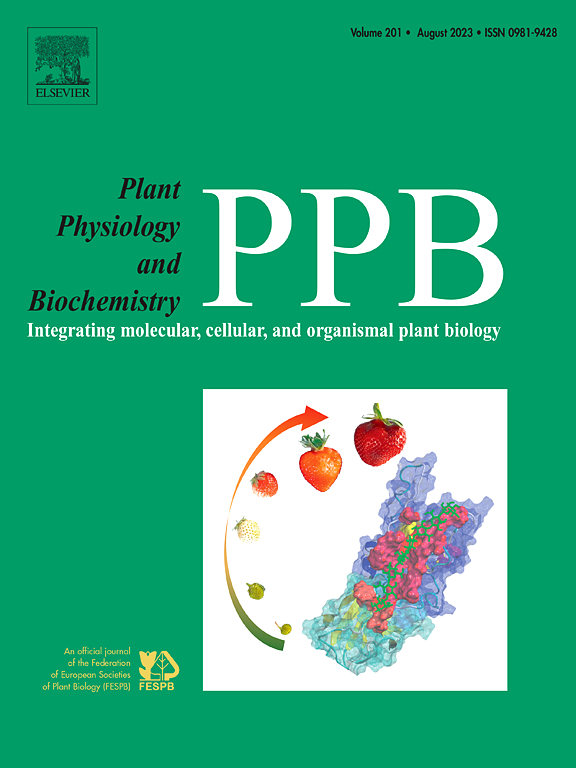Improved water-use strategies in oilseed rape transformed with Rhizobium rhizogenes under soil drought
IF 6.1
2区 生物学
Q1 PLANT SCIENCES
引用次数: 0
Abstract
Root-inducing (Ri) lines are plants that have undergone transformation with Rhizobium rhizogenes in which the transfer (T)-DNA of the bacterium has been incorporated into their genomes. Two Ri lines of Brassica napus (A11 and B3), developed in our lab, demonstrated improved tolerance to osmotic stress compared to the wild-type (WT) plants grown in hydroponics. However, these responses have not been confirmed for plants grown under soil drought. In the current study, A11 and B3 exhibited better maintenance of hydraulic integrity under conditions of severe soil drought, as exemplified by higher leaf water potential and delayed decline of daily plant water consumption in response to drought. In respect to the higher water maintenance, both Ri lines exhibited lower stomatal conductance (gs) and transpiration rate (Tr) (0.4 times lower than WT) under drought, which could be attributed to their significantly higher concentrations of leaf abscisic acid (ABA). Therefore, the improved water-use strategies in the Ri lines under severe soil drought could be attributed to ABA-mediated fine-tuned control of gs and thus Tr compared to WT. We furthermore analyzed the T-DNA insertion events in the two Ri lines and found that a high copy number of TL-DNA genes (rolA, rolB, rolC, rolD, and ORF13) and complete T-DNA insertion (both TL-DNA and TR-DNA) seemed to be correlated with a more severe Ri phenotype (e.g., dwarfing). Finally, the potential association of morphological modifications after T-DNA insertion with drought resilience in Ri oilseed rape was discussed. These findings provide evidence that R. rhizogenes-mediated transformation can be beneficial for developing pre-breeding oilseed rape lines coping better with drought stress.
土壤干旱条件下根瘤菌转化油菜改良水分利用策略
诱导根系是经过根瘤菌转化的植物,其中细菌的转移(T)-DNA已被纳入其基因组中。本实验室开发的两个Ri系(A11和B3)与水培野生型(WT)植物相比,对渗透胁迫的耐受性有所提高。然而,在土壤干旱条件下生长的植物,这些反应尚未得到证实。在本研究中,A11和B3在严重的土壤干旱条件下表现出更好的水力完整性维持,表现为叶片水势更高,植物日耗水量对干旱的响应延迟。在较高的水分维持能力方面,两系在干旱条件下气孔导度(gs)和蒸腾速率(Tr)均较低(比WT低0.4倍),这可能是由于其叶片脱落酸(ABA)浓度显著高于WT。因此,与WT相比,Ri系在严重土壤干旱条件下的水分利用策略的改善可能归因于aba介导的gs和Tr的微调控制。我们进一步分析了两个Ri系的T-DNA插入事件,发现高拷贝数的TL-DNA基因(rolA, rolB, rolC, rolD和ORF13)和完整的T-DNA插入(TL-DNA和Tr - dna)似乎与更严重的Ri表型(如矮化)相关。最后,讨论了Ri油菜T-DNA插入后形态修饰与抗旱性的潜在关联。这些研究结果表明,根瘤菌介导的转化有利于培育更好地应对干旱胁迫的预育种油菜品系。
本文章由计算机程序翻译,如有差异,请以英文原文为准。
求助全文
约1分钟内获得全文
求助全文
来源期刊
CiteScore
11.10
自引率
3.10%
发文量
410
审稿时长
33 days
期刊介绍:
Plant Physiology and Biochemistry publishes original theoretical, experimental and technical contributions in the various fields of plant physiology (biochemistry, physiology, structure, genetics, plant-microbe interactions, etc.) at diverse levels of integration (molecular, subcellular, cellular, organ, whole plant, environmental). Opinions expressed in the journal are the sole responsibility of the authors and publication does not imply the editors'' agreement.
Manuscripts describing molecular-genetic and/or gene expression data that are not integrated with biochemical analysis and/or actual measurements of plant physiological processes are not suitable for PPB. Also "Omics" studies (transcriptomics, proteomics, metabolomics, etc.) reporting descriptive analysis without an element of functional validation assays, will not be considered. Similarly, applied agronomic or phytochemical studies that generate no new, fundamental insights in plant physiological and/or biochemical processes are not suitable for publication in PPB.
Plant Physiology and Biochemistry publishes several types of articles: Reviews, Papers and Short Papers. Articles for Reviews are either invited by the editor or proposed by the authors for the editor''s prior agreement. Reviews should not exceed 40 typewritten pages and Short Papers no more than approximately 8 typewritten pages. The fundamental character of Plant Physiology and Biochemistry remains that of a journal for original results.

 求助内容:
求助内容: 应助结果提醒方式:
应助结果提醒方式:


